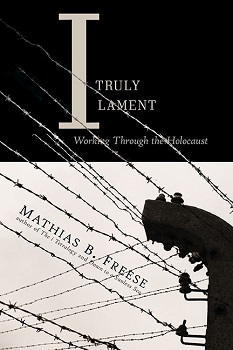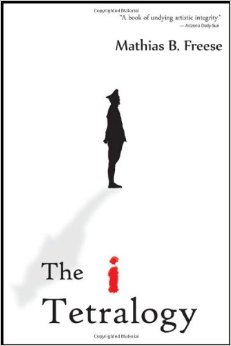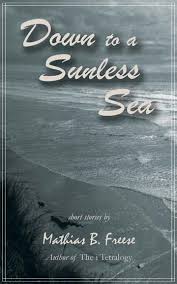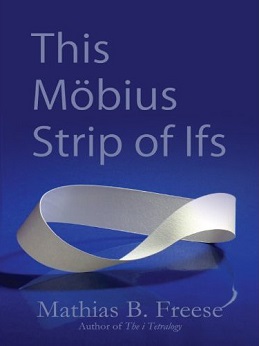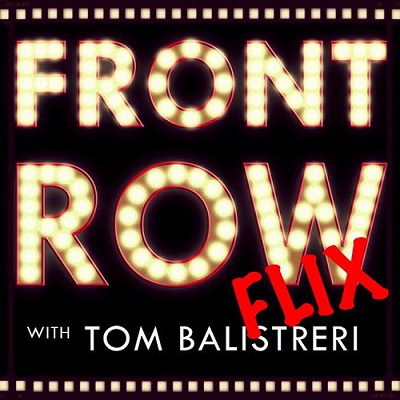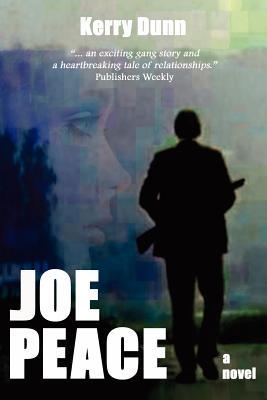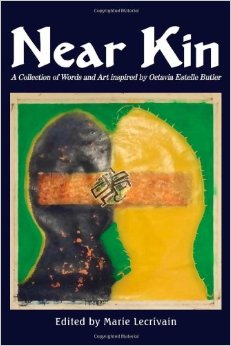
published 2014 by Sybaritic Press
188 pages
order a copy here
Learn and run. – Dawn
(The actual review follows this section.)
Finding Octavia
Anybody who grew up with Star Wars should be a science fiction fan. The adult intellectual in me appreciates the mixtures of Kurosawa, Flash Gordon and archetypal mythology in original trilogy, but the evergreen child in me still thrills at the ultra-exoticism, dashing heroes and ultimately doomed villains. Next to Kubrick’s 2001: A Space Odyssey, Star Wars has become the sci-fi nucleus for cinema, and my adoration of films such as Alien, Solaris (1972), Vanilla Sky, Europa Report, Gravity and the Matrix trilogy stems from that original childhood fascination.
As for sci-fi/speculative literature, I’m not an especial fan, and though I’ve stuff by Robert Asprin, Alan Dean Foster, A.C. Crispin, Isaac Asimov, Tim Sullivan, William Gibson, Philip K. Dick, Jerry Pournelle and Larry Niven (The Mote in God’s Eye is a masterpiece) and Arthur C. Clarke under my belt, my few favorites have been, are and always will be Robert Heinlein, Ray Bradbury and Michael Moorcock. From now on Octavia Butler will be included in that few. A huge honorable mention goes to C.S. Lewis’ underrated space trilogy, which includes Out of the Silent Planet, Perelandra and That Hideous Strength. In fact, much of Butler’s imagery and tone brought Perelandra to my mind more than a few times.
Though I’m familiar with works of some black writers who contributed to the sci-fi genre (including W.E.B. DuBois’ “The Comet” in Darkwater, Virginia Hamilton’s The Magical Adventures of Pretty Pearl, Sam Delany’s books, and even George Schuyler’s Black No More – which could have inspired Dr. Seuss’ The Sneetches), I’m not ashamed to admit that I’m relatively new to Octavia Butler. Many may blame this on her unlikely gender and race in a literary genre that tends to be manned by, well, men – and many who happen to be non-black. I don’t think so, but nor do I care. However, in order to have more authority to even think of writing a review of Near Kin, I insisted on familiarizing myself with Butler’s books, including Kindred, Survivor (the novel Butler herself repudiated), Parable of the Talents, Fledgling and Dawn. During my power-reading I also watched and read Butler interviews, as well as explored some related criticism. Needless to say, I was quite impressed, not to mention predisposed to be able to listen to her voice for three week’s straight if ever necessary. And her face. Butler had a remarkable face.
I picked Kindred as my virgin voyage since I’m a fool for almost anything to do with time travel. Back to the Future is my mini-religion, and Terry Gilliam’s 12 Monkeys continues to fascinate me. I’m even one of the few goofballs on this planet who love that 1994 Van Damme stinker, Time Cop. Kindred is up there with books such as Jack Finney’s Time and Again and Time After Time (of which Butler’s book reminds me), Daphne du Maurier’s The House on the Strand, and Audrey Niffenegger’s The Time Traveler’s Wife (which had to have been partly influenced by Butler’s novel). It cleverly and bravely takes time-travel literature to a different level by locating the main (and only) past location in the pre-Civil War South, smack-dab in the midst of American slavery, one of the most atrocious stains on U.S. history, not to mention world history.
The central protagonist, Dana, is torn from the 1970s to 1815 Maryland every time Rufus, the son of a plantation/slave owner, is in mortal danger as he matures from boy to man. Dana learns that Rufus’s existence is crucial to her own existence, since he eventually impregnates Alice, a slave, with a daughter who Dana’s key maternal ancestor. This is one of many examples of Butler’s interest in symbiosis rather than black-and-white (so to speak) user/used dichotomy. Like Marty McFly in Back to the Future, Dana must act in her own ultimate self-interest: set up the eventuality of her own birth. She does succeed – with a price. Aside from learning first-hand that whites and blacks are inexorable in U.S. history, she literally leaves part of herself in that sinful, horrible era, and that era marks her with the truth of that past for the rest of her days. On the final return from the past, her arm becomes fused with a wall and must be amputated for removal.
Which brings us to the elephant that seems to be in every room in which books by black authors are read: race. Honestly, like John Coltrane, I like to judge an artist by his or her “sound” rather than skin color or heritage, and I’ve long since grown bored with the artistic segregation of so-called black literature, no matter how good the intentions for such a categorization are. Black History Month is twelve months long.
There shall be and should be no forgetting of American slavery, but there are those who question how long society should wear its sackcloth in morose memory of that mass sin. That question oversimplifies the matter. Kindred’s Dana says to her husband at one point: “You’d think I would have had enough of the past,” but as she becomes more and more immersed in the real history of her doomed ancestors, she realizes that it’s not necessarily a one-sided decision. As the line goes in P.T. Anderson’s film masterpiece, Magnolia, “we may be through with the past, but the past ain’t through with us.” “I want to suggest that history is not the past. It is the present. We carry our history with us. We are our history” James Baldwin write in “Black English: A Dishonest Argument.” Atrocity stains deeply; it cries from the soil. This is why Faulkner was obsessed with his Southern heritage that belonged to both free whites and captive blacks.
While Sori, the female protagonist in Fledgling, Butler’s vampire novel, seeks to restore the lost memory of her past, Dana’s ancestral past is forced on her by inexplicable circumstances. With her direct experience and undeniable knowledge of such barbarism, she is no longer content in her relatively civilized, sanitized present:
“You might be able to go through this whole experience as an observer…But now and then…I can’t maintain the distance. I’m drawn all the way into eighteen nineteen, and I don’t know what to do. I ought to be doing something. I know that.”
The sin of slavery (which was once Earth’s norm, and is still aching in the human heart to reign again) is as worthy of reiteration and analysis as the Shoah, but there shouldn’t be some unwritten rule that black writers must always address the “black experience” in her or his works any more than every Jewish writer needs to write a Holocaust book. Yes, “racial” writers often pigeonhole themselves, but narrowing Octavia Butler’s awesome contribution to science fiction down to the rarity of her race and gender in the sci-fi field just sucks. “Black history” is inexorable from American history; “black art” is inexorable from American art; Butlerian sci-fi is inexorable from American sci-fi. Butler certainly tends to focus on race both literally and symbolically in her work, but her overall theme is humanity and what it is to be human – and this takes place in particular individuals rather than representative masses. When Joan Fry wondered about using the term “black” or “African American” in an interview with Butler, Butler exclaimed, “Oh, Lord! Labels again!” Her primary goal was to write a good story, but her work has more than one level, and some of those levels certainly play with issues of being black and the history of the Atlantic Slave Trade. “I have no idea who picks up on them and who doesn’t,” Butler said. “I think some of the academics do, because they expect you to do things like that.”
In a 1963 interview Ralph Ellison said that “all novels are about certain minorities; the individual is a minority.” Ayn Rand said as much in her famous “The smallest minority on earth is the individual” line. “If the Negro, or any other writer, is going to do what is expected of him,” Ellison went on to say, “he’s lost the battle before he takes the field.” He also summed up what I’ve come to believe and what Kindred and many of Butler’s other books seem to imply: “One ironic witness to the beauty and universality of this art is the fact that the descendants of the very men who enslaved us can now sing the spirituals and find in the singing an exaltation of their own humanity.” This is why nobody owns the blues and everybody owns the blues. And why jazz (that messiah of the prophet blues), is as ubiquitously American as superhero comic books.
A very refreshing aspect of Butler’s insight into race is her fairness about who can exhibit racist or, at least, prejudicial behavior. We tend to always hear about white people who find interracial dating and marriage odious, but what’s behind closed doors of the black family is rarely revealed. Often, what both old-fashioned white and black fathers can agree on for sure is that they don’t want their kids hooking up with each other. In Kindred, Dana, a black woman, asks Kevin, a white man, what his sister thinks of the prospect of their matrimony. He admits that she, despite her liberal sensibilities, disapproves – but soon we learn that so does Dana’s uncle and, to a lesser degree, her aunt:
“She doesn’t care much for white people, but she prefers light-skinned blacks. Figure that out. Anyway, she ‘forgives’ me for you. But my uncle doesn’t…He wants me to marry someone like him – someone who looks like him. A black man.”
This honest revelation reminds me of the black side of the conflict in Guess Who’s Coming to Dinner. John Prentice, Jr., played by Sidney Poitier, rejects his father’s old-fashioned prejudice against his loving and wanting to marry a white woman – and self-prejudice: “You think of yourself as a colored man. I think of myself as a man.”
In a critical essay on Kindred, Robert Crossley (University of Massachusetts at Boston) does a brief but worthy study of the book.However, he loses me when he says things such as this: “Some of [science fiction in the 1940s and 1950s] was provocatively racist, including Robert Heinlein’s The Sixth Column (1949), whose protagonist in a future race war was unsubtly named Whitey.” First of all, a scholar spieling about sci-fi literature should be a little more nuanced and less obtuse. Secondly, I think it’s ironic that Butler probably owes a lot to Heinlein. I almost refuse to doubt that she read his Methuselah’s Children, for instance. The controversial Farnham’s Freehold (1965) was not his story to begin with. Rather, it was a cleanup job for a story called “All” by science-fiction editor John W. Campbell, who undeniably had some pretty problematic views on race and blacks in particular. Far from originating a racist tale, Heinlein actually reformed the story in order to flush out a lot of racist elements. The race stuff that’s left shows bigotry on both the heroes’ and enemies’ sides, particularly on the part of the PanAsians who consider themselves the superior race and view white folks as slaves. Politically incorrect by today’s standards, the characters’ epithets and jingoism (again, from both sides) can be offensive, but this was published during World War II, while suspicion of the Chinese and Japanese was high and, ironically, shortly before the Japanese attack on Pearl Harbor fulfilled a surprise attack by Asians that the book prefigured.
Heinlein was very conscientious about racism, and a lot of his positive characters were of non-white descent (Rico, the Filipino of the popularly misunderstood Starship Troopers, to name one). Farnham’s Freehold, which reiterates the Sixth Column theme of an enemy that thinks it’s the superior race, is often slammed for emphasizing racist stereotypes despite its apparent anti-racist premise. A manmade cataclysm causes a warp in time that relocates Hugh Farnham and his family about 2,000 years in the future. A dystopia in which whites (called “savages”) are victims of oppressive racism is run by a regime made up of a conglomeration of non-Caucasian races, the Chosen, who inherited the world whites destroyed (an ironic prefigurement of Manson’s warped Helter Skelter eschatology).
Some critics point to the cannibalism of the Chosen to be racist in its echoing of black-as-savage paranoia. (My mind goes to the misinterpretation of Evelyn Waugh’s Black Mischief, which satirized aristocratic white liberals rather than denigrated African natives.) One of the points of the book is that humanity at large tends to slip into such madness when power corrupts; the violent and abusive wheel turns. I’d bet that many of the folks who disdain Farnham’s Freehold wouldn’t be so fastidious about, say, Darius James’ rather insane Negrophobia, or by Bernardine Evaristo’s re-imaging of American slavery in Blonde Roots (2010), a novel that depicts whites being kidnapped and taken to the made-up continent of Aphrika to be enslaved and dehumanized in every way Africans were during the real thing. The female protagonist is branded with “KKK” (for Kaga Konata Katamba, her black master’s name) and forced to serve as a “house wigger.”
Consider the female protagonist in Heinlein’s masterful Friday (1982). Friday is an Artificial Person (AP), probably genetically engineered, who is an agent fulfilling clandestine missions for a wisecracking old genius known to her as Boss. She’s indistinguishable from actual humans except in physical prowess, resistance to pain, deadliness and mental acuity. The question of what is human and who is equal pops up again and again throughout the novel, and Friday becomes rather sensitive about implied and overt discrimination against APs as the story progresses. When her secret is revealed to her human polygamist family, one of a few sister wives castigates Friday for deceiving them: “I’ve never had to deal with a creature not of God’s Law before…[U]nder our laws…a nonhuman cannot enter into a marriage contract with human beings.” Before this blowup, Friday defends a stepdaughter’s decision to marry a Tongan man. Sister-wife Vicki states her case plainly: “Mixing the races is always a bad idea.” And Friday, deflated, replies: “You don’t know any better. You’ve never been anywhere and you probably soaked up racism with your mother’s milk.”
I can’t help but think of a similar passage from Octavia Butler’s Survivor, in which a character named Bea suggests that Neila, the stepmother of mixed-race protagonist Alanna, should consider allowing the child to be raised by “her own kind.” Neila, of course, is appalled.
The older woman sighed. “Oh, my. I knew this was going to be difficult. But, Neila, the girl isn’t white.”
“She’s Afro-Asian from what she says of her parents. Black father, Asian mother.”…
…”I thought that after you’d had a few days with the girl, you might… reconsider.”
There was the sound of Neila’s laughter. “Come to my senses, you mean.”
“That’s exactly what I mean!” snapped the older woman. “Several of us feel that you and Jules ought to be setting a better example for the young people here – not encouraging them to mix…”
In the world of Heinlein’s Friday, human suspicion of Artificial Persons serves as a metaphor for racism, obviously, but, more importantly, Boss’s repeated admonishments against Friday’s self-consciousness of artificiality are an excellent example of science fiction’s – certainly Octavia Butler’s – tendency to kick at basic traditional foundations to the point of extending “humanity” beyond “homo sapiens.” When Boss makes a comment about Friday’s birthright, she corrects him:
“Birthright.” Don’t make jokes, Boss…‘My mother was a test tube, my father was a knife.’”
“You are being foolishly self-conscious over an impediment that was removed years ago.”
“Am I? The courts say I can’t be a citizen; the churches say I don’t have a soul. I’m not ‘man born of woman,’ at least not in the eyes of the law.”
“’The law is an ass’…You are not only as human as Mother Eve, you are an enhanced human, as nearly perfect as your designers could manage.”
Again and again questions of the essence of humanity, genetics, cross-breeding, evolution and tension between the familiar and the Other dominate most science fiction, often with the intensity and radicalism found in, say, Donna Haraway’s breakthrough posthumanist essay, A Cyborg Manifesto. Another very successful and ingenious science-fiction author, Samuel Delany (whose novels Octavia Butler could never get into, by the way), takes these themes to the nth degree in his complex novel The Einstein Intersection (1967): genetically dynamic and volatilely mutating aliens take over a humanless Earth and try their damnedest to reach and maintain some sort of “normal” physical form and society, in emulation of the long-gone humans and their cultural scraps. This results in exploration of difference, the Other, assimilation, humanity, and the weird drama of DNA. As in Butler’s books, and perhaps more so, these themes needn’t be relegated to the black/white dichotomy. Believe it or not, more than black writers are concerned with these things. Humans are concerned with these things.
Butler has some pretty stark pet themes in her novels: problematic religions, captivity, pivotal female characters, characters raging against impossible odds and so on. But the problem of familiar versus Other (usually human versus superhuman or alien and explored through the literal and symbolic act of miscegenation, which dear William Faulkner beat almost to death in his wonderful masterpieces and less-worthy works) seems to be the deepest theme. Nikanj, a key alien in Dawn, the first novel in Butler’s Xenogensis series, says that “different is threatening to most species. Different is dangerous. It might kill you.”
Obviously the theme of the Other is prime ground for addressing racial barriers, and there have been many books that involve characters of the black and white races role-reversing in order to reveal something about what it’s like to be the Other, usually for the sake of imparting empathy and tolerance – even love – if not just holding a mirror up to what’s considered to be a self-blind racist society. Several examples include Mark Twain’s Puddn’head Wilson (1894), James Weldon Johnson’s The Autobiography of an Ex-Colored Man (1912), George Schuyler’s Black No More (1931), John Griffin’s true-life Black Like Me (1961), and Bernardine Evaristo’s Blonde Roots (2010).
I must admit that Butler’s attention to color, kind, insider/outsider, etc., borders on tiresome but never really elicits more than a half-humorous eye roll. Oh, Shori is the only black vampire among the Ina kind in Fledgling? And Ina are otherwise invariably chalk-white and blonde? What a surprise. The more interesting thing is that Sori must be told she is black, similarly to how Adam and Eve are said to have not known their own nakedness in Eden until the Serpent spilled the beans. A passage from Fledgling:
He started to leave, then turned back, frowning. “Ordinary sun exposure burns your skin even though you’re black?”
“I’m…” I stopped. I had been about to protest that I was brown, not black, but before I could speak, I understood what he meant.
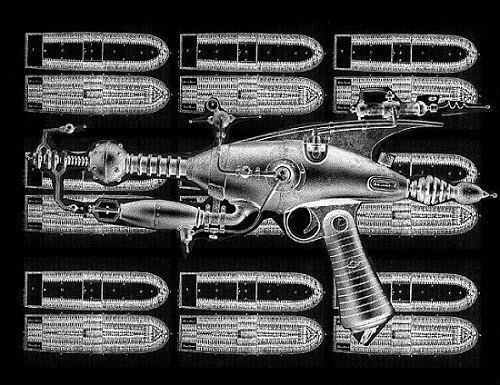 Days of Future Passed by Cacy Forgenie
Days of Future Passed by Cacy Forgenie
Much to my delight, it seems that Butler is too wisely pessimistic to believe in utopia as curative for human ills such as race-based prejudice. Instead, she acknowledges more genuine and palatable microcosmic healing rather than macrocosmic schemes. “It’s safer for people to overcome the feeling on an individual basis than as members of a large group,” said Ralph Ellison. How true. The breakdown of societal walls happens bit by bit and episode by episode. More generally, sincere love between humans happens on a heart-to-heart basis rather than by lofty edict. Neighborhoods on the sides of railroad tracks will always self-isolate while the brave and curious individuals who dare walk across those tracks will find that neighborhoods also can be neighbors.
Such microcosmic success is shown in the sexual intercourse between and marriage of human Lanna and alien Diut in Survivor. I always say that miscegenation is one of the keys to dampening racism, and here it is analogized in the love between different species. Aside from the hateful rivalry between two communities of the Kohn species (Garkohn and Tehkohn), tribal intractability is overtly shown in tension between Lanna and her Missionary foster father, Jules. Lanna reveals her coupling with Diut, and, despite his basic kindness and goodwill, Jules can’t justify these things with his Missionary religion. He questions the existential worth of the Tehkohn in general. In response Lanna insists on the “humanity” of her husband’s kind: “You know how human they are.” And Octavia Butler’s recurring problem with monotheism is evident in Jules’s reply:
“Physically humanlike, perhaps. But spiritually…what god do they worship?”
“…none.”
“On Earth, even the most primitive savages recognize some supreme being or beings, some power higher than themselves.”
“That might be true – on Earth.”
“Only animals were completely without spiritual beliefs.”
“On Earth!”
In Dawn protagonist Lilith is horrified by a master plan of joint procreation of hybrid children between captive humans and captor aliens. (The consequences of this master plan are shown in Adulthood Rites and Imago, and the Patternist series and Fledgling, also involve the theme of genetic manipulation and human evolution.) Loss of true humanity is what Lilith fears while her alien counterpart, Nikanj, thrills at the intended result:
“Our children will be better than either of us…Our children won’t destroy themselves in a war, and if they need to regrow a limb or to change themselves in some other way they’ll be able to do it.”
Lilith speaks for every anti-utopian when she replies:
“But they won’t be human. That’s what matters. You can’t understand, but that is what matters.”
As Nikanj observed earlier in the novel, humans “are horror and beauty in rare combination.” (I’m reminded of something Dmitri says in Dostoyevsky’s The Brothers Karamazov: “The awful thing is that beauty is mysterious as well as terrible. God and the devil are fighting there and the battlefield is the heart of man.”) This sums up the basic catch-22 that arises in all worthy dystopian works: the folly of throwing the baby out with the bathwater in the quest for perfection, absolute equality, and peace. In A Clockwork Orange, Alex’s Skinnerian/Pavlovian conditioning squeezes out his love of music, particularly Beethoven. In the superior 1978 Invasion of the Body Snatchers film love is the bathwater baby. Consider the eerie assurance of body-snatched Dr. Kibner: “We don’t hate you. There’s no need for hate now. Or love… Don’t be trapped by old concepts, Matthew, you’re evolving into a new life-form.” Even if some type of conditioning or deep sacrifice of human nature could vanquish racism Butler would reject it. “Ridiculous” was the word she used to describe utopias, and she admitted that perfect societies not only require perfect people but they’d be boring if achieved.
Of course, racists see race mixture as something just as extreme and traumatic as body-snatching. Consider many of the Nazis’ obsession with blood and eugenics, or Nation of Islam founder Fard’s tale of mad-scientist Yakub and the lab-originated white-devil race. The old “one-drop rule” is still alive and well in the world, particularly in America, and its “positive” mask hardly hides the basic racism. All racial chauvinism is poison.
It takes no genius to realize that Butler’s work tends to bring to mind the slave-narrative tradition. Characters face and work through captivity; some are even actual slaves. Novels such as Mind of My Mind, Survivor and The Parable of the Talents recapitulate the author’s fascination and concern with oppression, power and control. The recent film adaptation of 12 Years a Slave, Solomon Northup’s factual account of his kidnapping and unlawful sale into Southern slavery back in the 1850s, pleased me very much with its accuracy and near-verbatim treatment of the author’s confounding and deeply touching testimony. Reading of Kindred’s Dana’s struggle to get a letter that could lead to her manumission reminded me of the Northup book. And Butler’s Parable of the Talents (whose obnoxious journal format and monotony had me trudging uphill to its ending) deals with a future slavery rather than a past one.
Lauren Oya Olamina, co-narrator of the book (along with her daughter many years later), “hyperempath,” ex-Baptist (like Butler herself) and founder of a philosophy/religion called Earthseed, keeps a secret account during her people’s captivity under the fanatical (and annoyingly caricatured) Christian Crusade in a manner similar to Solomon Northup’s clandestine letter-writing: “I’ve hidden my writing paper, pens and pencils away in our prison room.” (Captive Lilith in Dawn also lobbies strongly for writing materials.) Olamina voices the general anguish of enslaved people and the particular injustice of violently amputating Africans’ heritage after bringing them to the so-called New World:
We’re expected to feed ourselves and our captors. They eat better than we do, of course…They’ve burned all that they could find of our past. It’s all ungodly trash, they say.
The imagined sci-fi future echoes and speaks for the real-world past, and Olamina reveals the deep price for both manumission and diaspora:
But we’re not slaves anymore…I’ve done this: I’ve sent my people away. We survived slavery together, but I didn’t believe that we could survive freedom together. I broke up the Earthseed community and sent its parts in all directions. I believe it was the right thing to do, but I can hardly bear to think about it…I’ve torn a huge hole in myself.
This figurative hole reminds me of the figurative and literal maiming of Dana at the end of Kindred. Butler explained her choice to have Dana lose her arm:
I couldn’t really let her come all the way back. I couldn’t let her return to what she was, I couldn’t let her come back whole and that, I think, really symbolizes her not coming back whole. Antebellum slavery didn’t leave people quite whole.
There is no total solution to the insoluble fact of atrocity and humans’ inhumanity to humans. And, as far as Butler is concerned, without a doubt, the answer certainly doesn’t lie in monotheistic religion, Christianity in particular. (Robert Heinlein also tends to sneer at religious fundamentalism, especially in Revolt in 2100, which features a dictatorial regime called the Theocracy.) Though her Baptist past informs her and a lot of her criticism of organized religion is right on and inarguable, much of Butler’s characterizations strike me as oversimplified and hackneyed. An odious creep named Andrew Jarrett – who’s from Texas, of course – embodies the Christian Crusade, a regime that is extremely oppressive and self-righteous as much as self-blind, an extreme and meaner version of Survivor’s Missionary sect.
The religion (non-religion?) of Earthseed, which is in tune with the natural unfolding of things and therefore right (a notion that is a distant cousin to de Sade’s nihilistic determinism, really) is pitted against the rather sophomoric Christian-chauvinist dystopia that has about as little real-world possibility as do Margaret Atwood’s The Handmaid’s Tale or Alan Moore’s V For Vendetta. “God is Change” sums up the credo of Earthseed, and a lot of bubblegum religiosity and what I call Zen-lite flows from that. Earthseed encourages adherents to help give shape to constant change, and doubters or Christians are seen as dumb dams butting up against creative rivers. Tellingly, Olamina negatively recalls a sermon from her childhood that hailed Jesus, who is “the same yesterday, today, and forever.” In Earthseed terms, the static Jesus is the opposite of God.
Olamina’s condescending brother protests: “You can follow Earthseed, build your way to go to the stars, fall down into chaos, and wind up in hell! Or you can follow the will of God.” And her friend Dan typifies the closed-minded, condescending Christian dogmatist: “It isn’t really religious – your service, I mean. You guys don’t believe in God or anything.” Personally, I shy away from both dogmatism and naturalism. I appreciate – need, can’t help but be both an agent and subject of – change, but I’m a willy-nilly child who doesn’t wish to have a willy-nilly parent, a wobbly wheel that wants a stable drivetrain. Improved civil rights is change, yes, but so are cataclysm and cancer.
G.K. Chesterton wrote that “satire may be mad and anarchic, but it presupposes an admitted superiority in certain things over others; it presupposes a standard.” Can’t that be applied to just about anything? Can change be change without a flux-resistant thing or concept? In a similar vein G.K. wrote: “[Y]ou cannot praise an action because it shows will; for to say that is merely to say that it is an action.” If God is change and change is God, then I’d hate to meet the devil.
I don’t want my personal thumbs down to ruin my praise for Octavia Butler, however. She belongs on the bookshelves of anyone who loves good science fiction and excellent literature in general. As author DL Warner says in Near Kin, “[Butler] presented universal themes on a down-to-earth level.” That’s Butler’s greatest strength, I think. The bottom (bottomless?) line for Butler is the question of humanity. What constitutes a human? What makes certain types of humans “worth more” than others? What happens when “human” is a judgment call made by beings – human or not – in power or with more power? In a sense, these are the same questions involved in thinking through the age-old institution of slavery – and I dare say that no eras of that once worldwide institution have been written of and studied more than the American one. This is just another reason to consider Butler a dyed-in-the-wool American writer, and a darn important one at that.
Near Kin
To be honest, I’m usually not a fan of tribute anthologies. Here’s what I wrote at the beginning of my review of From the Four-Chambered Heart: In Tribute to Anais Nin (another anthology published by Sybaritic Press):
Having heard and been disappointed by my share of tribute music albums, I often approach tribute literature with a grain of salt in one hand and keep the other hand free just in case I have to yawn. Maybe this attitude stems from my lifelong indifference to dressing up for Halloween, and emulous songs or writings seem like costumes rather than unique ensembles.
However, I ended up appreciating that book and speaking very highly of it, and I’m pleased to do the same for Near Kin: A Collection of Words and Art Inspired by Octavia Estelle Butler. The book is the only of its kind, as far as I can tell. When I first heard of the book, I wondered who the heck came up with the idea to do such an unlikely tribute. But that’s just what Near Kin’s charm is: someone showed due respect to Octavia Butler, and it’s about damn time!
Marie Lecrivain, poet, author, editor-in-chief of poeticdiversity and “editrix” of Sybaritic Press, edited the anthology and wrote its foreword in which she praises “[Butler’s] scary and wonderful worlds” and “her vision, bravery, artistry, and…her wish to fashion a better world than the one we live in now.” Mentioning Butler’s accomplishment of becoming the first black woman to win a MacArthur Genius grant, Marie makes sure to emphasize the author’s expertise rather over her genetic makeup: “I briefly pondered Butler’s racial origin, then cast it aside…I loved her writing!” This calls to my mind something that Ralph Ellison wrote in “The World and the Jug”: “While I am without a doubt a Negro, and a writer, I am also an American writer.” Marie reveals that Dawn is the book that inspired her to explore more of Butler’s work. I can see why. The book is extraordinary. (I am disappointed, however, that Marie didn’t include her own work in this collection.)
As with the Nin anthology, I can take or leave the interspersed illustrations and photographs in Near Kin – which is not to say that I don’t dig them. My favorites include Cacy Forgenie’s Days of Future Past and Justus (the front-cover image), Lance Tooks’ Kindred (taken from the front cover of his graphic-novel adaptation of the novel), Fabiola Jean-Louis’ lovely Balance and Birth of the Seed (which is on the cover of the Kindle edition of the book) and Marissa Lafferty’s Space Lady (which looks like a sci-fi version of Josephine Baker). I do think that I’d be more partial to the inclusion of the visual art if color printing and/or glossiness had been feasible or affordable. Fabiola’s paintings could have especially shined.
Though I liked some pieces more than others in Near Kin, I must congratulate every contributor for her or his enthusiasm and care for the inspiring author. Octavia Butler deserves both the admiration and emulation. The works range from intentionally derivative to very vague (as far as reference to Butlerian writing goes), and I have to say that perhaps I appreciated the stuff in between those poles.
The prose piece that impressed me the most is Alexis Pauline Gumbs’ “A Litany for Survivor: The Book That Octavia Didn’t Want Us to Remember,” the text of a presentation done at UC Riverside’s Critical Ethnic Studies: Settler Colonialism and the Future of Genocide in 2011. The essay, on the whole, is excellent, though I diverge from some of its core notions. Gumbs shares some theories on why Butler ended up repudiating Survivor and wanted it to fade away. Her first guess is that the author shied away from the premise of humans living among “a somewhat humanoid species of folks who are hairy, and deep blue, or green.” Then she reiterates what is probably the most popular theory (since Butler herself expressed it): that the author was ashamed of the “little green man in outer space” cliché. Finally Gumbs builds on the initial theory and wonders if Butler feared “danger in a racist society” in response to depicting the communal, “very hairy” and “darkest blue people had the most power.”
First of all, I can’t accept Butler’s own “little green man” rationale. It’s so weak and unsubstantiated, since so many of her books star the equivalents of little green men, and so does the science-fiction tradition in general. And the basic things that save any sci-fi work from failure due to the “little green man” cliché are a good story and good writing. Butler had both of those locked.
I also reject the fear that a majority of white society (“vastly racist” is problematic) would scorn or, at least, ignore, a science-fiction novel in which the most endowed beings have a lot of hair and dark colors. Here’s how Gumbs puts it: “[Butler] feared the blacker-the-berry logic she employed would be misinterpreted.” On the contrary, I doubt that, by the time of Survivor’s publication, the majority of contemporary readers, particularly sci-fi fans, were so meticulously bigoted as to be insulted that gorilla-like beings that constantly change colors (note: including bright ones) were physically stronger and more savvy than white colonists on another planet in some fantastic existence. That’s a stretch I can’t accept. (The popular Planet of the Apes movies had just culminated five years earlier, after all.) If anything, wouldn’t the scenario of a black woman repeatedly saving, castigating and eventually killing a white man incense racist whites and also render the Kindred novel unsavory in Butler’s eyes? I just don’t think she had such a weakness in her. (And I think hairiness occurs among both blacks and whites.)
However, I’m somewhat in accord with Gumbs’ thoughts about “commodification of black women’s creativity” and her note that Butler herself worried about being “tokenized.” (Humorous aside for Survivor fans: one might say that Alanna wasTehkohnized.) Gumbs points out that Butler was frustrated by apparently being “the only black woman science fiction writer” and encouraged others like her to get into the genre. That’s understandable, but I think too much of a big deal is made about quantification of kinds in different fields. Not every low count is an unjust or undue dearth. Often it’s a matter of cultural patterns. Why does there seem to be a preponderance of Jewish people in comedy? Why are there so many Hispanic males and so relatively few women in comic-book art? And, at the risk of flippancy, I ask: why else are there so few hockey players of Asian descent?
Gumbs does go into the chronic tragedy of an alarming number of black women being slain in their own communities back in the 1970s, particularly in 1972 Boston, as well as the 1979 Atlanta Child Murders. She ties the outrage and ignited activism of many black women to the term “survivor” and wonders if the connotation of that word soured Butler to the very title of her novel. The word is justifiably more important to Gumbs and black female activists, I think, because in a racial context it not only defines those who stand against and live in spite of racial oppression, but, as Gumbs says:
By claiming my survival, and my survivorhood, I’m placing my life in the context of our collective dead whom genocide sought, and seeks to destroy, but cannot erase, because I’m here continuing to witness our dead by saying, I am a survivor. Saying “I am a survivor,” is a ritual that invites the dead to continue participating in the creation of the present moment, and the future.
A powerful thought indeed. Butler didn’t think that blacks had made peace with themselves, and whites still had yet to make peace with blacks, but, as Gumbs admits, Butler isn’t on record as addressing this angle in regard to her apparent disdain for Survivor at all. However, there is one thing Butler said that comes close to what Gumbs posits. While discussing the irresponsible behavior of the black man who’s paired with Lilith for sexual intercourse by the Oankali, she explained that “his situation is reminiscent of the survival characteristics that black people developed as a result of slavery, characteristics that were useful in slavery but detrimental later.” Perhaps the old but persistent and now negative modes of survival ruin “survivor” as a positive term?
I’m in line perfectly with Gumbs when it comes to desiring that others read Survivor though its author wouldn’t want them to. Of this artistic violation we are both complicit. Do we know better than Butler? Is Gumbs seeing the novel’s worth in regard to black heritage and “keep on keeping on” in the face of hatred and obliteration, while I see so much more than a Star Trek novel and think that Survivor is an integral piece of the Butlerian puzzle? Whatever, Survivor survived death, even after its very creator tried to kill it. And now the book continues as a witness to the deceased author, inviting her to participate “in the creation of the present moment, and the future,” as Gumbs puts it. Similar to Dana’s wall-fused arm in Kindred, it seems that the novel stays with us despite its artistic amputation by the author.
(By the way, I also agree with Gumbs when she says “I really don’t think the way she writes dialogue is all that convincing, or great.” This was particularly strong for me in the speech of the characters from 1815 in Kindred.)
Another favorite piece in Near Kin is DL Warner’s “Identity,” which is a brief essay on how Octavia Butler inspired embracement of her identity and to apply that identity honestly and fearlessly to her own writing. Warner is always outspoken about her belief that well-written erotica deserves more respect than it gets. I agree with her wholeheartedly. While explicit violence is overlooked or justified in the critical world, explicit and unconventional sexuality tends to be shunned or minimized as pornography.
Comic-book maestro Alan Moore and feminist artist Melinda Gebbie collaborated on the epic graphic-novel series, Lost Girls, in order to counter the prejudice against erotic art in both the written and visual fields. X-rated and then some, the result is a delicious, surreal and mores-traumatizing explosion: literary, contextual and high-quality, which is what Moore and Gebbie intended, and what DL Warner also intends.
Warner relates an incident that happened while Warner participated on a Star Trek panel in which a snooty sci-fi novelist objected to her calling the Trek universe on its frigidity, its lack of sexuality. When he quipped that injecting sex into science fiction didn’t make her “a second rate Octavia Butler,” she replied that just as “being brown, female and a sci-fi writer” didn’t necessarily warrant identification with Butler, “his being pale and doughy [didn’t make] him Alfred Hitchcock.” I hope she took a bow after that one! However, Pasty Doughboy unwittingly emboldened her trust in her art. Considering Butler’s pride in her subject matter, Warner decided to forge ahead without shame or shyness about her own work: “Thus, I stepped out of the shadows, assumed my true identity and hid my erotica no longer…I am forever grateful to Octavia Butler for that freedom.”
Well, DL Warner has to like M. Justine Gerard’s very erotic “Small Talk,” which is one of my two favorite fiction pieces in Near Kin. It’s a subtle sci-fi story that takes place in a society that puts a premium on speech. Yes, speech. Forget the saying “Look but don’t touch.” This story involves “Look, touch – but don’t talk.” A man named Niall propositions a reluctant prostitute named Benaya, and the reader eventually learns that in this society citizens can tongue-kiss and engage in oral, anal and any other kind of sex – but conduct no conversation. This law isn’t obvious until the end of the story, which makes its assault on our talkative sensibilities that much more impactful. For example, not knowing the clever gimmick until later, one might be both confused and curious during the preliminary “interview” between Benaya and Niall:
“Kiss?”
“Yes.”
“Tongue?”
“Yes.”
“Blow-job?”
“Condom.”
“Anal?”
“Condom.”
“Bare-back?”
“Condom!”
He smiled. She realized Niall was teasing her.
“Words?”
Red flag. Benaya raised an eyebrow.
“No,” she declared.
If Niall had asked “Talk?” there wouldn’t have been as much mystery, since it’d be understandable that a prostitute would want to avoid much verbal involvement. But “Words?” is an odder request. Niall might be interested in tongue-kissing and both oral and anal sex, but he requests words specifically – without joking. In fact, the request worries Benaya. Why? The no-words concept is quite clever in its playing with prostitutes’ mythical “no kissing” rule (which was probably popularized by Pretty Woman) and its turning “Talk is cheap” on its head. Imagine how much we take words for granted, let alone the luxury of open-ended discussions or even ecstatic exclamations during great sex. Much to both her dismay and delight, Benaya learns quickly that Niall is not only well-hung but he can deliver the goods. She avoids alcohol because it loosens the tongue and might waste precious words in a talk-regulating world, but it’s next to impossible to stay mum when a lover hits the spot.
Benaya moaned. Niall was massive. She bit her lip and did her best to keep silent. Clearly, he can tell how much I like this. Fuck, I have to keep my mouth shut!
Niall flexed inside her. Surprised, Benaya opened her mouth.
“Ohg…”
I love how Banaya suppresses even the during-sex cliché of “Oh God!” What would make people so afraid to talk – or even moan words ecstatically – freely? How did such self-censorship – worse: self-silencing – become such powerful policy? Gerard doesn’t explain, and I’m pleased that she doesn’t. As far as we know it just is, like the sudden time-travel in Octavia Butler’s Kindred or the worldwide stoppage of male sperm count in P.D. James’s Children of Men.
After some mind-blowing fucking the Benaya and Niall fall asleep together. When they’re both awake Niall presses her on his forbidden request again:
“Say something to me. Please. Say anything.”
Benaya cringed. She felt trapped. This was not part of their agreement. Quickly, she jumped out of bed, grabbed her dress and her shoes…
…“I need to speak. More than I need art, food, sex, money. I need to save myself from the silence. Please, speak to me!”
“No!”
“Why?”
“Death!”
Interestingly and tellingly, the last – and probably most poignant – word Benaya says to Niall before fleeing is “sorry.”
“Small Talk” is a splendid example of what DL Warner spoke about in “Identity”: “erotica [as] a valid subject to explore artistically.” Gerard incorporates rock-solid (I can attest!) erotica, which is explicit enough to be called pornographia, into a solid science-fiction story. The formula works.
My other favorite fiction piece is Alex Hernandez’s “A Thing of Soft Bonds,” out-and-out science fiction without a doubt. It has the smoothness and technical elaboration of Robert Heinlein and the feminist/metamorphosis tropes of Octavia Butler. (Both writers tended toward ethnodecentralization, and the characters in this story have a good handful of diverse names: Villaneuva, Chen, Puig, Sousa-Cruz, Foluke, Jackson and Rodriguez.) If I had to teach a class about what makes a good short story in general I’d probably use this one as one of the primary examples.
“A Thing of Soft Bonds” contains all the goodies: a spaceship in distress, a crew at the point of no return to safety (in this case a space station), an outside threat (in this case a violently horny all-male penal colony), dystopian desperation (in this case a shortage of women), mind versus might (in this case a geneticist against a brutish General), the primitive consuming the so-called civilized (in this case overstimulated neurotransmitters enslaving an enemy), science’s fine line between help and harm (in this case knowledge of and experimentation with biology and genes giving otherwise helpless women a chance at survival), and gender-bending and tampering with what it is to be homo sapien (in this case a “man” without a Y-chromosome and a female-to-male transgendered man, as well as…well, you’ll see).
The spaceship Ashaba is under assault by the leading General of the penal-colony planet because he wants to commandeer any women on board for recreational rape to serve as a pressure valve for the prisoners. While the leading men of the Ashaba are fatalistic about the inevitable horrors the ship’s women must face, Barbara Villaneuva, Chief Scientist of the mission, immediately starts to brainstorm an alternative to either gang rape or execution once they’re overwhelmed and taken down to the criminal planet. The ship’s captain commits suicide, and there are no weapons with which to defend the crew.
The very Butlerian feature of the story is the central reason for the space mission: collection of alien tetradecapodal animals. With all the odder-than-oddness of Butler’s Oankali, each one of these creatures looks “like a furry, arboreal octopus with fourteen arms.” And each one is not really a one but “a colony organism, made up of fifteen individual-but-connected specimens.” See, the species’ immobile female, who is all brain and sensory organs – “and fourteen clasping vaginas,” eventually drives fourteen males into a “mindless, writhing” state with her mature scent so that they are driven “into on orgy that would forever bind them in perfect union.” This symbiotic relationship provides the female with strength and the ability to ambulate “with the nimble elegance of [a] gibbon[.]” What can Barbara do with no weapons and nothing but her alien specimens and laboratory?
You see where this is going. With a marvelous deftness and lexicon Hernandez presents a surprisingly believable (though not necessarily fully understood) gambit thought up by the quite resourceful and brave Barbara: she decides to use available genomes and nano-bacterium (I think) to concoct a biochemical defense against the approaching threat. After injecting herself with chromosomes containing “genomic snippets from bees, ants, termites, naked mole rats” for a few weeks, Barbara’s appearance and body chemistry changes drastically, to say the least.
The athletic body she had prided herself in was no avocado-shaped and glistening with perspiration…Stretch marks split her brown skin like lightning…
…“What is that smell?” Helen Chen froze at the entrance, aghast. “It smells like rotten meat and stale piss in here!”
“That’s me,” Barbara said, facing the ship’s coordinator…
Barbara then explains to Chen – and us – the logic in her seemingly mad experiment:
“My endocrine system is quite extraordinary now. I’m secreting powerful messenger chemicals – it’s what you’re smelling – they elicit the over-production of neurotransmitters in men: dopamine, serotonin, oxytocin, vasopressin and others. To their unsuspecting minds, I exist both as loving mother and magnificent lover.”
Barbara’s reek, while seeming to be repellent at first, is really an attractant. And it comforts her students, who have voluntarily accepted transgenic modifications in order to have a chance at being spared rape or death by the coming prisoners. The students’ changes aren’t as evident as Barbara’s but if separated from her and her comforting scent, they too will become the enormous, “curvy” being that takes the fertile rotundity of Paleolithic Venuses to a whole new level. Barbara wants the rest of the crew, including the questionably gendered Rodriguez and the female-to-male Jackson, to inject her blood in order to complete the clever standoff. Later, Jackson participates enthusiastically, but Rodriguez refuses, echoing a protest that is usually likely to come from an Octavia Butler character, not to mention countless characters in sci-fi/speculative literature. And he learns another of Barbara’s…enhancements:
“So my choices are to live like a subhuman or become something less than human? Fuck that! I choose to be my own person! Even if that means dying.” He took a swing at Barbara, but she easily caught his wrist. He struggled and tried to pull away, but the muscles beneath her flab were now incredibly dense. She was twice as strong as any man, even a carefully crafted one.
Eventually the men led by scumbag Sousa-Cruz breach the Ashaba. Gushing with stinky sweat, Barbara simply reveals her mountainous naked body: “Everything slowed as biology took over.”
Barbara only stood there, enthralled by the sight of the men swaying like blades of grass in a breeze. They literally vacillated with anticipation, their gun barrels wavering from their mark.
Does Barbara’s plan succeed? Sniff, sniff, sniff…
A lot, if not all, of the other Butler-inspired fiction in Near Kin is pretty good. Some titles that surface when I think of it are “Waking Dr. Wexler” by Angel Uriel Perales (a wonderfully written story that seems to involve a sort of time travel, at least via madness or dementia), “No More Stories” by Jordan Alam (in which characters experiment with a device that allows for the virtual piggybacking on other people’s dreams), “In the Beginning” by Meghan Elison (which seems to be an excerpt from or an offshoot of her dystopia novel, The Book of the Unnamed Midwife), “Sweet Autumn” by Charie D. Le Marr (which involves empaths, probably in honor of Butler’s The Parable of the Sower/Talents), and “Saint of the Unknown Universe” by Linda Ravenswood (in which a woman kills her abusive man, discovers that he was a robot all the while, and wonders how she’d ever become pregnant).
 Balance by Fabiola Jean-Louis
Balance by Fabiola Jean-Louis
Much of Near Kin’s poetry is very worthy as well. “Dreams of the Slave” is written by Walidah Imarisha, a teacher, writer, spoken-word artist, “historian at heart, reporter by (w)right [and] rebel by reason” (her words). The format of the poem is quite…vertical, which helps one imagine it being performed by the author. The narration is full of slave imagery and the plaintive patterns of the oppressed; the narrator mourns the loss of her sold love. She remembers his wise words of hope and assurance, but in the absence of her love she wants “the night sky to go black./Suck up the light/and leave only darkness.” Her despair turns to joyous rejuvenation when her love directs her toward freedom, symbolically pointing North and evoking the Underground Railroad, Harriet Tubman and the bravery of both escapees and the whites and blacks who pitched in despite the great risk. That freedom was earned in part by the slaves whose blood was shed and still cries from the ground, and it seems to be symbolized in what I interpret as a vision of an old ex-slave woman who holds out her hands to show scarred wrists but no chains, a sort of transfiguration.
The weight of hope
is crushing me,
and I no longer
care to struggle
for breath.
But when I look to the heavens
my love is there.
Smiles,
teeth pinpricks of light.
My love
points north,
and I see
the stars take another shape:
round face
intense eyes –
hair growing like
untamed cotton.
Her broad lips
the shape of freedom.
I look at her wrists:
No chains –
There are scars
but no chains…
…And I heard the whisper:
It was not in vain.
Nothing was in vain…
…You
will not
be lost…
Sticking with the subject of slavery, Sherese Francis had Kindred as her inspiration for “Give Me Your Hand”:
You pull me
back in need of saving
But I am pulled
for me and you…
Your survival
hinged on my back,
and I have the leathery scars
to remember
our strange symbiosis…
There are many kinds of slaves, of course. As we saw earlier, slavery can result from biochemical perfect storms, as it was posited in Alex Hernandez’s “A Thing of Soft Bonds.” Michelle Angelini unwittingly sings Hernandez’s tune in her poem “On Becoming Part of the Crowd”:
I transition
as if turning from a teenager
to an adult with a more
intensive hormonal overdose,
It is exquisite torment – too much…too much…
Will I survive going through it?
I belong
Now I’m inside the circle and have power
over others. They are slaves without
knowledge and I gained
a unique power.
What will it be?…
“There Is Nothing Inconsistent” by David Scriven is deceptively simple but resonates (how I hate that term!) long after it’s read. At once surreal, animistic and metaphysical, it has a slight Octavia Butler feel: weirdness, nature, the ever-present threat of death, the grayness rather than stark contrasts of the human heart.
…There is nothing inconsistent
About believing that
The smell of rotting flesh
Tells the presence of a ghost…
…There is nothing inconsistent
About believing that
A man is evil,
Or good,
Or that words cannot hurt you.
Julia Stein indirectly celebrates Butler’s feminism in a poem called “1996.” She reveres women protesting a clothing business propped by Thai sweatshop workers, martyred union-activist Fannie Sellins, Russian-born unionizer Sara Plotkin, whose championing of laborers once touched the steel industry of Pittsburgh, my hometown. Female activism is viewed as a suprabiological family, a maternal heritage that paves the road for each new wave of collective praxis:
They whispered to use their secrets, handed them down,
mother to daughter. We have their courage as their inheritance.
Just as our mothers walked across the coal fields
we have begun to walk across the land.
Interestingly, in spite of Butler’s celebrated feminism, she has been criticized (perhaps most notably by feminist Dorothy Allison) for not adequately transcending patriarchy and domesticity, and for having her female protagonists identify with or assimilate to the agents of the power structure or dominant culture.
Reviewer Cherry Wilder included Survivor in what she saw as a negative fantastic trend in science fiction: “The female fantasy that is currently gathering momentum seems to run as follows: ‘I was the chosen mate of a large, alien-looking male.’” And, in another contemporary review of the novel, Geraldine Morse bashed what she saw as the basic implication in the unlikely coupling of Alanna and Diut:
If you enjoyed Mandingo, that titillating tear-jerker about the lust of a white plantation mistress for her black slave, you’ll probably enjoy Survivor, which raises the tension at least theoretically by introducing a pleasant bestiality in the male partner, who would closely resemble a six foot tall blue gorilla if such a thing existed. Survivor isn’t a bad book, and the ploy of miscegenation perks up an otherwise uneventful story, but with apologies to the gorilla, there’s no real meat in it.
What all the authors and artists in Near Kin share is a fundamental appreciation and reverence for Octavia Butler, and some of the poetry addresses this directly. Wanda Smith’s “Octavia’s Brood and Vision” evokes Ray Bradbury, who seems to be an obvious influence in Butler. Smith parallels their careers, praising Butler for her more complex characters, and ending the poem with this magnificent imagined scene:
Up among stars on the Milky Way Ray Bradbury
looks around and blinks.
Octavia E. Butler throws him a kiss and winks.
Smith also wrote “Octavia and Playboy,” which addresses the inclusion of such sci-fi giants as Heinlein and Bradbury in the pages of Playboy in the 1960s, and how Butler and other female writers never made it “on pages/between the bunnies,” let alone the Playboy Book of Science Fiction. Smith produces yet another great imaginary afterlife encounter to close the poem:
If Octavia and Hef do meet among stars in the heavens
she will probably ask, “Hugh who?”
Tara Betts’ “A Sonnet for Octavia Butler” (which I like far more than her other poem, “God is Change”) is biographical:
[S]he burrowed into books – other worlds.
This was one way to speak, a slight curve
toward a future only she could write…
Ink continued to bite
teeth marks into her pages, where change
became God and women felt the past’s lash
and collared futures that echoed the bleak
lives of so many, like her mother, smashed
beneath nightmares that poverty often wreaks…
Perhaps the most powerful tribute to the honored author is in Cat Angelique McIntire’s “Haiku for Octavia Butler,” which has an imaginary Butler as narrator:
don’t look so damn smug –
you’ll all be compared to me.
few will measure up.
– David Herrle, 10/2014

